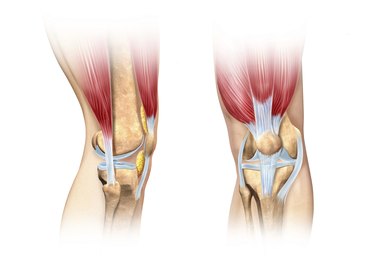
The junction where two bones meet is a joint, also known as a bony articulation. With more than 200 bones in the human body, there are several different types of joints that give the body both mobility and stability. Joints are divided into three groups: freely movable, slightly movable, and immovable. Freely movable joints, also known as diarthrosis joints, are the most common in the body. Different types of freely movable joints allow varying movements in different parts of the body.
Ball-and-Socket Joints
Video of the Day
The largest joints of the body, at the hips and the shoulders, are ball-and-socket joints. The end of the upper arm and leg bone is rounded, appearing much like a half ball. This bony ball fits into a cup-like socket. Ball-and-socket joints provide the greatest range of movement of all the freely movable joint types. The upper arms and legs are capable of moving backward, forward, and to the side, as noted by Brigham and Women's Hospital. In addition, a ball-and-socket joint allows for rotation of the long bones, providing the arms and legs with a remarkable range of complex movement.
Video of the Day
Hinge Joints
Hinge joints act much like the hinges on doors. They permit back and forth movement, but not side-to-side or lateral movement. The elbows, the knees, and the middle and end joints of the fingers are hinge joints. Hinge joints are prone to injury when lateral forces are applied to the joint. Many knee injuries occur in this manner, according to the National Institute of Arthritis and Musculoskeletal and Skin Diseases.
Pivot Joints
Pivot joints are specially suited for rotating movements. The articulation between the atlas and axis bones in the neck is a pivot joint, which enables the head to turn from side to side. Pivot joints also join the two bones of the forearm, notes Dr. Monique Laberge in the "Encyclopedia of Nursing and Allied Health."
Ellipsoidal Joints
Ellipsoidal or condyloid joints permit angular, bending movements but with limited rotation. You can examine the flexibility and limitations of an ellipsoidal joint by moving your index finger. The joint at the base of the index finger is an ellipsoidal joint. As noted in the human anatomy section of Minnesota State University's EMuseum, other joints in the wrist, hands and feet are also ellipsoidal joints.
Saddle Joints
The carpometacarpal joint at the base of the thumb is the only saddle joint in the human body. The lower bone of the joint resembles a saddle. The upper bone fits into the "saddle." The saddle joint allows the thumb to move toward the palm, enabling you to grasp objects between your thumb and fingers.
Is this an emergency? If you are experiencing serious medical symptoms, please see the National Library of Medicine’s list of signs you need emergency medical attention or call 911.